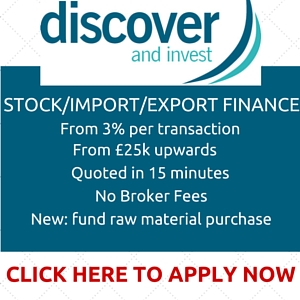For firms that are involved in importing and exporting goods, there has always been access to import finance, but rarely export finance. But this is now changing rapidly.
Firms can now look to fund not only the purchase of finished goods, but also the purchase of raw materials along with the funding of their overseas invoices. This article will explain what you need to know in order to access and unlock this exciting new finance product.
Globalisation reduces Lending Risk
The historical problem for a lender has always been the jurisdiction of the customer, or debtor. With import finance, the end debtor is in the UK, and therefore it has been much easier to credit score, or assess them. In the event of default, chasing a firm based in the same country as the lender is clearly advantageous.
However, with the onset of globalization, and the need for a more standardized approach to business, the consequence has been the beginnings of a standardized approach to global lending. The consequence of that is lenders are beginning to feel less risk when assessing customers overseas, particularly if they have global offices, or are trading in different territories.
(I hasten to add this trend has only just begun, but there is clear evidence of a more relaxed view to funding exported products).
So there are now some export finance possibilities in the marketplace, but what exactly do you need to know in order to unlock this product?
What you need to know
Below are 11 pointers to help you understand and unlock this funding:
1. Funding the Start of the Product Sales Cycle
The introductory comment in this product is the fact that you are now able to fund the earliest possible stage of your product and sales cycle. i.e. the purchase of your goods, or raw materials. This form of funding is available at a much earlier stage than invoice, or global receivables finance, and therefore can significantly help cash flow during large growth phases.
2. How long you’ve been in business is not critical
Funding is approved based on the business model, not the length of time your firm has been in business. Traditional funding routes usually require 2 years filed accounts, and as a result tend to have a much lower interest rate to reflect the lower risk they take in lending to that type of business. However, if you do not have 2 years filed accounts, it does not mean you cannot access funding.
Even a start-up can qualify, should early orders be in place.
3. How much profit you’re making is not critical
Equally how much profit you’re currently making is not a deciding factor in whether lending is available, although the same rules tend to apply as with length of business. Again start-ups with no current trading, but with strong orders ready to go, can get funded.
Although facilities can differ, you typically pay back a lender after the sales revenue has arrived, not out of existing cash flow. Therefore usually (but not always), there is no debt to service on a regular basis, only at the end.
4. Margins and Timeframe criteria
Alongside some form of experience, the key aspects needed to unlock this type of funding is the overview of the business cycle. They are what type of product, what margins the borrower makes, and how long it takes to get paid, once the order has been placed. This type of funding tends to be fairly short-term in nature i.e. a facility that is fully repaid over a maximum 5-6 month period (is typically paid out of sales at the end when paid, not existing cash flow). As a result, funders need to see that an efficient model is in place.
5. Knowing if you are eligible
If have a UK presence of some description and are a manufacturer, importer, exporter, wholesaler, distributor, stockist or retailer, then you are provisionally eligible.
6. Your relationship with suppliers
A key element is whether you have worked with your suppliers before. If not, then it is still possible to get some funding, but it may not be 100% of the purchase price on the first batch of stock/raw materials ordered.
7. How your overseas debtors credit score
One of the major tasks a lender will undertake will be to credit score your overseas customers. If they fail, it is unlikely you will get funded.
You can short cut this process yourself initially by using global credit scoring systems, or more practically, enquiring with a credit insurance firm, who will do the due diligence for you.
8. Funding the End of the Product Sales Cycle
We discussed earlier how export finance essentially funds the start of the cycle, in a way other finance products cannot. There is also invoice finance for overseas customer that can be added, and indeed works as complimentary product. Invoice finance rates are much lower, and can come in to take out export finance at the appropriate juncture. As a result, the combination of both products ensures cashflow is not an obstacle at the start, and then reduces the overall cost of finance half way through.
9. Fund the purchase of raw materials
This is a very new area, not just in export but also import finance. This means that if you are a manufacturer, or have a manufacturing element to your business, funding does exist to purchase raw materials where once there was not.
10. Understanding what else it can do for your business
There is a really important strategic benefit to knowing and using this form of finance.
There is no real limit to how much funding you can access, which means businesses have the chance to grow at a much a quicker rate than would otherwise be possible.
This realisation means, for example, you can go and chase a big contract that you would otherwise not chase because now you have the cash to purchase a large volume of stock in order to service. The fact that you now can chase big contracts means better turnover, and stronger profits, quicker.
The knock-on effect of this change in circumstance is your firm can then get access to much cheaper levels of high street bank funding at a much earlier stage in your business lifespan. To repeat, the quicker your turnover and profits grow, the quicker you get to the High Street Bank. Surely that has to be worth knowing about.
11. Other forms of non-related business finance
It is also worth understanding that should this type of funding not work for you, or you get declined, there are other types of generic business finance that may well be available. There is a wave on new unsecured and secured business funding in the marketplace for working capital purposes, which are either backed by Director’s Personal Guarantees, or through the assignment of legal charges on differing types of property. It is certainly another avenue worth exploring.
What do you want to do now?
I want to read more articles on this subject...click here
I want more information on how this product works...click here
I want help putting together an application...click here
I want to make an enquiry...click here
About Chris Davidson
Chris Davidson is Managing Director of Discover & Invest Ltd.
He believes passionately in providing businesses with market-leading financial insights that have a positive impact on the bottom line. As a result, Chris helps get the best rates and terms available at any one time.
Connect with Chris on Facebook, LinkedIn and Twitter to keep abreast of the latest market offerings.






